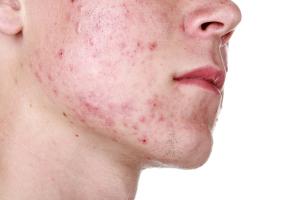
Acne vulgaris is a physically and psychologically scarring condition, and it’s all to common. Although evidence linking diet and acne is still in its infancy, it is extremely promising. Unfortunately however, many dermatologists still believe that the two are unrelated… I would beg to differ. In western countries, acne is a nearly universal skin disease afflicting 79% to 95% of the adolescent population (as well as a large chunk of adults). In comparison, epidemiological studies show that acne is almost unheard of in non-westernised populations. Interesting.

Dysbiosis is when your gut becomes somewhat “pathogenic” due to an imbalance of good and bad bacteria…too many baddies, and not NEARLY enough of the goodies. Now, our intestinal barrier is the main interface between us and the external environment, and where there is a BARRIER BREAKDOWN of the skin… there is almost ALWAYS barrier breakdown of the gut. In the literature, this is referred to as the “gut-skin axis”.
What causes “barrier breakdown” in the gut?
- Gluten! Click here for more info on why gluten in one of the major drivers of intestinal permeability (or “leaky gut”)
- The Western diet! Sulphites, refined grains, refined sugars, trans-fats, processed dairy, caffeine, imported seafood, grain-fed meats, lack of fibre all lead to a “Westernised” microbiome.
- Food sensitivities/intolerances
- Low stomach acid/ enzyme insufficiencies
- Antibiotic use – especially during foetal growth/early childhood. Did you know that the average Australian will have 10-20 courses of Antibiotics before the age of 18?!
- Other Medications – including the oral contraceptive pill, and some anti-inflammatories
- Chronic constipation
- Smoking, Alcohol
- Excessive cleanliness
- Stress
- Parasitic infections

This is a very simplified explanation of the cascade linking the gut to acne:
- The above factors cause dysfunctional gut flora and increased intestinal permeability (aka “a leaky gut”), and a change in gut pH
- A dysfunctional gut flora and increased intestinal permeability lead to systemic inflammation and oxidative stress
- Oxidative stress and inflammation lead to acne development!
Don’t get me wrong, there are many other “drivers” of acne such as nutritional deficiencies, hormonal imbalances (i.e. PCOS), high circulating insulin, excessive androgens, sugar/refined grains, processed cow’s milk, genetic susceptibility, etc. However, my experience as well as some pretty extensive studies would indicate that poor gut health is one of the main causes of acne.
So what’s the best treatment?
Well, that ALL depends on the cause! For example, if the cause is undiagnosed food sensitivity, versus a history of excessive antibiotic use, the treatment and recommendations will be different. I often recommend a comprehensive stool analysis; as it indicates pH imbalances, parasitic infections, bacterial levels, enzyme levels, etc… and we can get a bulls-eye treatment plan together.
I believe the best diet for acne is one that is incredibly nutrient dense, is alkaline, has plenty of soluble fibre, pre-biotic foods, greens, favourable fats, has a low glycaemic load, and is based on the principles of the “primal” diet. I also find that Zinc, ‘green’ powders, strain-specific probiotics and digestive enzymes can be extremely beneficial. It’s critical to identify what is preventing you from having glowing, healthy skin; and I truly believe that looking at your diet and gastrointestinal environment is the perfect place to start.
Until next time, Stacey.
References:
Cordain L, Lindeberg S, Hurtado M, et al. Acne vulgaris: a disease of Western civilization. Arch Dermatol. 2002 Dec;138(12):1584-90.
Bowe WP, Logan AC. Acne vulgaris, probiotics and the gut-brain-skin axis – back to the future? Gut Pathog. 2011 Jan 31;3(1):1.
Guarner F, Malagelada JR. Gut flora in health and disease. Lancet. 2003 Feb 8;361(9356):512-9.
Zhang H, Liao W, Chao W, et al. Risk factors for sebaceous gland diseases and their relationship to gastrointestinal dysfunction in Han adolescents. J Dermatol. 2008 Sep;35(9):555-61.
